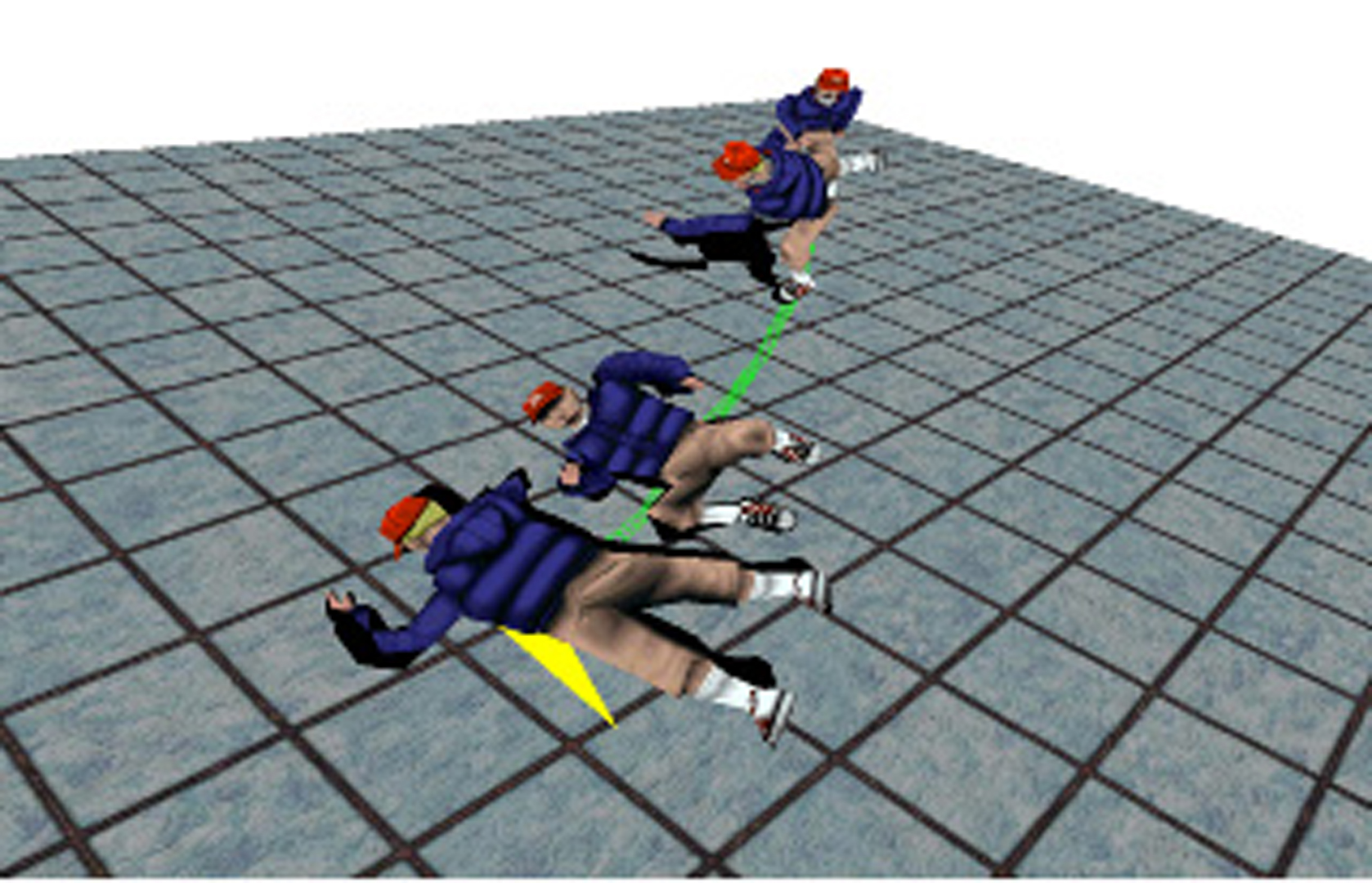“Interactive motion generation from examples”
Conference:
Type(s):
Title:
- Interactive motion generation from examples
Presenter(s)/Author(s):
Abstract:
There are many applications that demand large quantities of natural looking motion. It is difficult to synthesize motion that looks natural, particularly when it is people who must move. In this paper, we present a framework that generates human motions by cutting and pasting motion capture data. Selecting a collection of clips that yields an acceptable motion is a combinatorial problem that we manage as a randomized search of a hierarchy of graphs. This approach can generate motion sequences that satisfy a variety of constraints automatically. The motions are smooth and human-looking. They are generated in real time so that we can author complex motions interactively. The algorithm generates multiple motions that satisfy a given set of constraints, allowing a variety of choices for the animator. It can easily synthesize multiple motions that interact with each other using constraints. This framework allows the extensive re-use of motion capture data for new purposes.
References:
1. BISHOP, C. M. 1995. Neural Networks for Pattern Recognition. Clarendon Press, Oxford. Google Scholar
2. BOWDEN, R., 2000. Learning statistical models of human motion.Google Scholar
3. BRAND, M., AND HERTZMANN, A. 2001. Style machines. In Proceedings of SIGGRAPH 2000, 15-22. Google Scholar
4. BROGAN, D. C., METOYER, R. A., AND HODGINS, J. K. 1998. Dynamically simulated characters in virtual environments. IEEE Computer Graphics & Applications 18, 5, 58-69. Google Scholar
5. CHENNEY, S., AND FORSYTH, D. A. 2000. Sampling plausible solutions to multi-body constraint problems. In Proceedings of SIGGRAPH 2000, 219-228. Google Scholar
6. CHOI, M. G., LEE, J., AND SHIN, S. Y. 2000. A probabilistic approach to planning biped locomotion with prescribed motions. Tech. rep., Computer Science Department, KAIST.Google Scholar
7. DEMPSTER, W., AND GAUGHRAN, G. 1965. Properties of body segments based on size and weight. In American Journal of Anatomy, vol. 120, 33-54.Google Scholar
8. EFROS, A. A., AND LEUNG, T. K. 1999. Texture synthesis by non-parametric sampling. In ICCV (2), 1033-1038. Google Scholar
9. FORTNEY, V. 1983. The kinematics and kinetics of the running pattern of two-, four- and six-year-old children. In Research Quarterly for Exercise and Sport, vol. 54(2), 126-135.Google Scholar
10. FUNGE, J., TU, X., AND TERZOPOULOS, D. 1999. Cognitive modeling: Knowledge, reasoning and planning for intelligent characters. In Proceedings of SIGGRAPH 1999, 29-38. Google Scholar
11. GALATA, A., JOHNSON, N., AND HOGG, D. 2001. Learning variable length markov models of behaviour. In Computer Vision and Image Understanding (CVIU) Journal, vol. 81, 398-413. Google Scholar
12. GERSHO, A., AND GRAY, R. 1992. Vector Quantization and signal compression. Kluwer Academic Publishers. Google Scholar
13. GILKS, W., RICHARDSON, S., AND SPIEGELHALTER, D. 1996. Markov Chain Monte Carlo in Practice. Chapman and Hall.Google Scholar
14. GLEICHER, M. 1998. Retargetting motion to new characters. In Proceedings of SIGGRAPH 1998, vol. 32, 33-42. Google Scholar
15. GRZESZCZUK, R., AND TERZOPOULOS, D. 1995. Automated learning of muscle-actuated locomotion through control abstraction. In Proceedings of SIGGRAPH 1995, 63-70. Google Scholar
16. GRZESZCZUK, R., TERZOPOULOS, D., AND HINTON, G. 1998. Neuroanimator: Fast neural network emulation and control of physics based models. In Proceedings of SIGGRAPH 1998, 9-20. Google Scholar
17. HEEGER, D. J., AND BERGEN, J. R. 1995. Pyramid-Based texture analysis/synthesis. In Proceedings of SIGGRAPH 1995, 229-238. Google Scholar
18. HODGINS, J. K., AND POLLARD, N. S. 1997. Adapting simulated behaviors for new characters. In Proceedings of SIGGRAPH 1997, vol. 31, 153-162. Google Scholar
19. HODGINS, J., WOOTEN, W., BROGAN, D., AND O’BRIEN, J., 1995. Animated human athletics.Google Scholar
20. KOVAR, L., GLEICHER, M., AND PIGHIN, F. 2002. Motion graphs. In Proceedings of SIGGRAPH 2002. Google Scholar
21. LAMOURET, A., ANDVAN DE PANNE, M. 1996. Motion synthesis by example. In Eurographics Computer Animation and Simulation ’96, 199-212. Google Scholar
22. LATOMBE, J. P. 1999. Motion planning: A journey of robots, molecules, digital actors, and other artifacts. In International Journal of Robotics Research, vol. 18, 1119-1128.Google Scholar
23. LEE, J., AND SHIN, S. Y. 1999. A hierarchical approach to interactive motion editing for human-likefigures. In Proceedings of SIGGRAPH 1999, 39-48. Google Scholar
24. LEE, J., CHAI, J., REITSMA, P., HODGINS, J., AND POLLARD, N. 2002. Interactive control of avatars animated with human motion data. In Proceedings of SIGGRAPH 2002. Google Scholar
25. LI, Y., WANG, T., AND SHUM, H. Y. 2002. Motion texture: A two-level statistical model for character motion synthesis. In Proceedings of SIGGRAPH 2002. Google Scholar
26. MATARIC, M. J. 2000. Getting humanoids to move and imitate. In IEEE Intelligent Systems, IEEE, 18-24. Google Scholar
27. MCMAHON, T. 1984. Muscles, Reflexes and Locomotion. PhD thesis, Princeton University Press.Google Scholar
28. MOLINA-TANCO, L., AND HILTON, A. 2000. Realistic synthesis of novel human movements from a database of motion capture examples. In Workshop on Human Motion (HUMO’00), 137-142. Google Scholar
29. NELSON, R., BROOKS, C., AND N. PIKE. 1977. Biomechanical comparison of male and female distance runners. In Annals of the NY Academy of Sciences, vol. 301, 793-807.Google Scholar
30. O’ROURKE, J. 1998. Computational Geometry in C. Cambridge University Press. Google Scholar
31. POPOVlC, Z. 1999. Motion Transformation by Physically Based Spacetime Optimization. PhD thesis, Carnegie Mellon University Department of Computer Science. Google Scholar
32. PULLEN, K., AND BREGLER, C. 2000. Animating by multi-level sampling. In Computer Animation 2000, 36-42. ISBN 0-7695-0683-6. Google Scholar
33. PULLEN, K., AND BREGLER, C. 2002. Motion capture assisted animation: Texturing and synthesis. In Proceedings of SIGGRAPH 2002. Google Scholar
34. ROSE, C., GUENTER, B., BODENHEIMER, B., AND COHEN, M. F. 1996. Efficient generation of motion transitions using spacetime constraints. In Proceedings of SIGGRAPH 1996, vol. 30, 147-154. Google Scholar
35. SCHODL, A., SZELISKI, R., SALESIN, D., AND ESSA, I. 2000. Video textures. In Proceedings of SIGGRAPH 2000, 489-498. Google Scholar
36. VEACH, E., AND GUIBAS, L. J. 1997. Metropolis light transport. In Proceedings of SIGGRAPH 1997, vol. 31, 65-76. Google Scholar
37. WITKIN, A., AND POPOVIC, Z. 1995. Motion warping. In Proceedings of SIGGRAPH 1995, 105-108. Google Scholar






